University Report: Brexit's Impact on UK Recruitment and Immigration
VerifiedAdded on 2022/12/09
|16
|3695
|275
Report
AI Summary
This report examines the impact of Brexit on UK organizations' recruitment processes, based on a dataset of 2053 organizations across public, private, and voluntary sectors. The study analyzes primary data to determine whether organizations plan to grow or shrink their workforce, identify potential markets for new staff, and assess the implications of a new points-based immigration system. The analysis focuses on key questions related to recruitment plans, redundancies, and the employment of EU nationals, comparing trends between private and public sectors. Findings indicate that private sectors are more actively planning to recruit employees in the next three months, while the majority of organizations do not plan any redundancies. The report also explores the impact of Brexit on the employment of EU nationals and provides recommendations for the implementation of an effective immigration system.

Using Data to Build Business Practice -
BSS004-1
1
BSS004-1
1
Paraphrase This Document
Need a fresh take? Get an instant paraphrase of this document with our AI Paraphraser
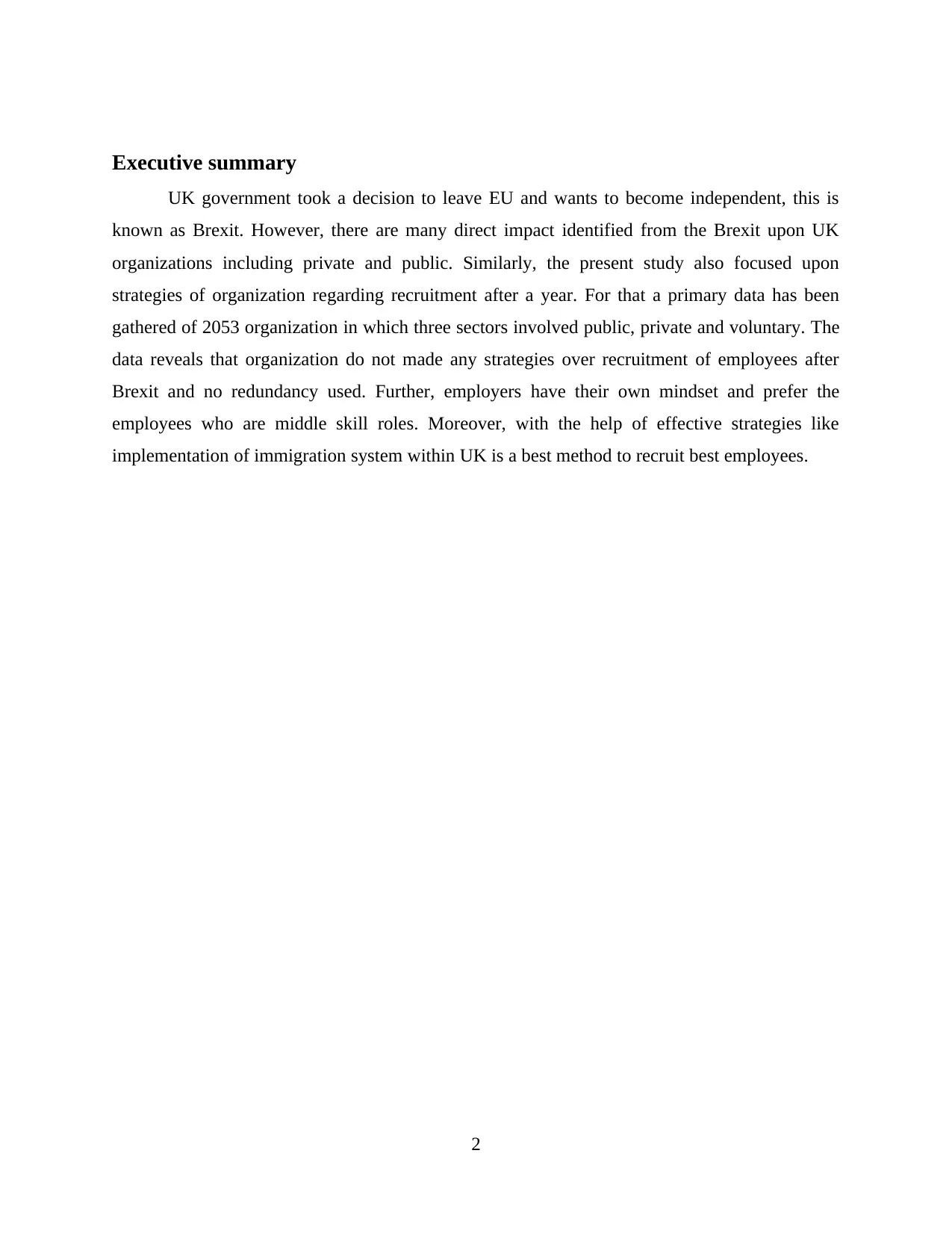
Executive summary
UK government took a decision to leave EU and wants to become independent, this is
known as Brexit. However, there are many direct impact identified from the Brexit upon UK
organizations including private and public. Similarly, the present study also focused upon
strategies of organization regarding recruitment after a year. For that a primary data has been
gathered of 2053 organization in which three sectors involved public, private and voluntary. The
data reveals that organization do not made any strategies over recruitment of employees after
Brexit and no redundancy used. Further, employers have their own mindset and prefer the
employees who are middle skill roles. Moreover, with the help of effective strategies like
implementation of immigration system within UK is a best method to recruit best employees.
2
UK government took a decision to leave EU and wants to become independent, this is
known as Brexit. However, there are many direct impact identified from the Brexit upon UK
organizations including private and public. Similarly, the present study also focused upon
strategies of organization regarding recruitment after a year. For that a primary data has been
gathered of 2053 organization in which three sectors involved public, private and voluntary. The
data reveals that organization do not made any strategies over recruitment of employees after
Brexit and no redundancy used. Further, employers have their own mindset and prefer the
employees who are middle skill roles. Moreover, with the help of effective strategies like
implementation of immigration system within UK is a best method to recruit best employees.
2

TABLE OF CONTENTS
Executive summary.........................................................................................................................2
INTRODUCTION...........................................................................................................................4
Presenting the data provided to develop an understanding of information required by
government..................................................................................................................................4
Questions that needs to analyze in order to provide effective results..........................................5
Analyze the data from the selected questions..............................................................................6
Recommendations pertaining to proposed new immigration system on organization..............13
CONCLUSION..............................................................................................................................14
REFERENCES..............................................................................................................................16
3
Executive summary.........................................................................................................................2
INTRODUCTION...........................................................................................................................4
Presenting the data provided to develop an understanding of information required by
government..................................................................................................................................4
Questions that needs to analyze in order to provide effective results..........................................5
Analyze the data from the selected questions..............................................................................6
Recommendations pertaining to proposed new immigration system on organization..............13
CONCLUSION..............................................................................................................................14
REFERENCES..............................................................................................................................16
3
⊘ This is a preview!⊘
Do you want full access?
Subscribe today to unlock all pages.

Trusted by 1+ million students worldwide
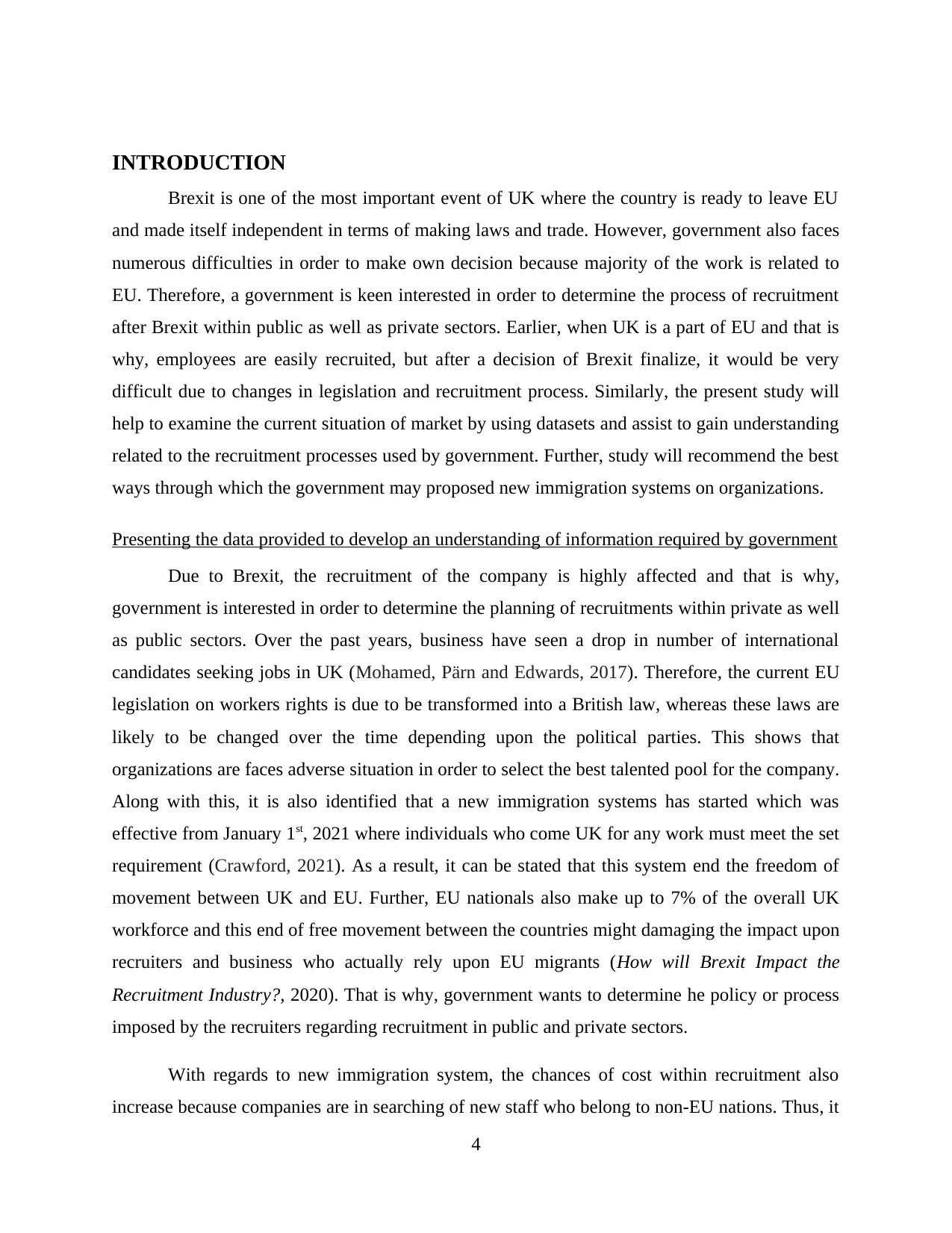
INTRODUCTION
Brexit is one of the most important event of UK where the country is ready to leave EU
and made itself independent in terms of making laws and trade. However, government also faces
numerous difficulties in order to make own decision because majority of the work is related to
EU. Therefore, a government is keen interested in order to determine the process of recruitment
after Brexit within public as well as private sectors. Earlier, when UK is a part of EU and that is
why, employees are easily recruited, but after a decision of Brexit finalize, it would be very
difficult due to changes in legislation and recruitment process. Similarly, the present study will
help to examine the current situation of market by using datasets and assist to gain understanding
related to the recruitment processes used by government. Further, study will recommend the best
ways through which the government may proposed new immigration systems on organizations.
Presenting the data provided to develop an understanding of information required by government
Due to Brexit, the recruitment of the company is highly affected and that is why,
government is interested in order to determine the planning of recruitments within private as well
as public sectors. Over the past years, business have seen a drop in number of international
candidates seeking jobs in UK (Mohamed, Pärn and Edwards, 2017). Therefore, the current EU
legislation on workers rights is due to be transformed into a British law, whereas these laws are
likely to be changed over the time depending upon the political parties. This shows that
organizations are faces adverse situation in order to select the best talented pool for the company.
Along with this, it is also identified that a new immigration systems has started which was
effective from January 1st, 2021 where individuals who come UK for any work must meet the set
requirement (Crawford, 2021). As a result, it can be stated that this system end the freedom of
movement between UK and EU. Further, EU nationals also make up to 7% of the overall UK
workforce and this end of free movement between the countries might damaging the impact upon
recruiters and business who actually rely upon EU migrants (How will Brexit Impact the
Recruitment Industry?, 2020). That is why, government wants to determine he policy or process
imposed by the recruiters regarding recruitment in public and private sectors.
With regards to new immigration system, the chances of cost within recruitment also
increase because companies are in searching of new staff who belong to non-EU nations. Thus, it
4
Brexit is one of the most important event of UK where the country is ready to leave EU
and made itself independent in terms of making laws and trade. However, government also faces
numerous difficulties in order to make own decision because majority of the work is related to
EU. Therefore, a government is keen interested in order to determine the process of recruitment
after Brexit within public as well as private sectors. Earlier, when UK is a part of EU and that is
why, employees are easily recruited, but after a decision of Brexit finalize, it would be very
difficult due to changes in legislation and recruitment process. Similarly, the present study will
help to examine the current situation of market by using datasets and assist to gain understanding
related to the recruitment processes used by government. Further, study will recommend the best
ways through which the government may proposed new immigration systems on organizations.
Presenting the data provided to develop an understanding of information required by government
Due to Brexit, the recruitment of the company is highly affected and that is why,
government is interested in order to determine the planning of recruitments within private as well
as public sectors. Over the past years, business have seen a drop in number of international
candidates seeking jobs in UK (Mohamed, Pärn and Edwards, 2017). Therefore, the current EU
legislation on workers rights is due to be transformed into a British law, whereas these laws are
likely to be changed over the time depending upon the political parties. This shows that
organizations are faces adverse situation in order to select the best talented pool for the company.
Along with this, it is also identified that a new immigration systems has started which was
effective from January 1st, 2021 where individuals who come UK for any work must meet the set
requirement (Crawford, 2021). As a result, it can be stated that this system end the freedom of
movement between UK and EU. Further, EU nationals also make up to 7% of the overall UK
workforce and this end of free movement between the countries might damaging the impact upon
recruiters and business who actually rely upon EU migrants (How will Brexit Impact the
Recruitment Industry?, 2020). That is why, government wants to determine he policy or process
imposed by the recruiters regarding recruitment in public and private sectors.
With regards to new immigration system, the chances of cost within recruitment also
increase because companies are in searching of new staff who belong to non-EU nations. Thus, it
4
Paraphrase This Document
Need a fresh take? Get an instant paraphrase of this document with our AI Paraphraser

is not possible to recruit the employees from oversees (Cameron and Marson, 2018). In
accordance with the dataset in which 2053 organizations are selected in order to determine their
recruitment process. Further, it can be stated that around 813 organizations are planning for the
recruitment within next 3 months whereas, 1032 organizations including private and public
sectors are not going to be recruited within next years. Therefore, it can be stated that not 50% of
the total organizations are planning to recruit the employees but they helps in the growth of firm
for next years. Apart from this, the survey also reflected that within next three months there are
direct impact upon the recruitment industry. Such that the findings reflects that out of 2053,
around 1008 organizations are stated that in order to maintain total staff level, they want to
recruit the employees, whereas 380 of them stated that it act as a promoters and that is why, it
can be stated that there will be a minor growth in the industry (Tiwasing, 2021). However, as
soon as time passes, companies will definitely focus upon the employees recruitment and then
make effective strategies as well.
Questions that needs to analyze in order to provide effective results
In order to determine the planning of organizations, it is necessary to select important
information from the data provided so that it provide valid and reliable results. This analysis is
important because it help to determine whether the organizations are planning to grow or shrink
their workforce, where the potential market for new staff are seen to be. Thus, there is no need
to select or interpret all the information from the data, also due to limited word limit, some
questions has been chosen from the five categories. These selected questions are sufficient
enough in order to make comparison between private and public sectors and determine the action
taken by the firm regarding the organization’s recruitment processes due to Brexit.
There are different question selected from the range of given data, these are as mentioned below:
Q1) Is your organisation planning to recruit employees in the next THREE months?
Q 3) Is your organisation planning to make any redundancies during the next THREE months?
Q4) Thinking about the next THREE months, what will be the overall effect of recruiting new
staff and/or making redundancies?
5
accordance with the dataset in which 2053 organizations are selected in order to determine their
recruitment process. Further, it can be stated that around 813 organizations are planning for the
recruitment within next 3 months whereas, 1032 organizations including private and public
sectors are not going to be recruited within next years. Therefore, it can be stated that not 50% of
the total organizations are planning to recruit the employees but they helps in the growth of firm
for next years. Apart from this, the survey also reflected that within next three months there are
direct impact upon the recruitment industry. Such that the findings reflects that out of 2053,
around 1008 organizations are stated that in order to maintain total staff level, they want to
recruit the employees, whereas 380 of them stated that it act as a promoters and that is why, it
can be stated that there will be a minor growth in the industry (Tiwasing, 2021). However, as
soon as time passes, companies will definitely focus upon the employees recruitment and then
make effective strategies as well.
Questions that needs to analyze in order to provide effective results
In order to determine the planning of organizations, it is necessary to select important
information from the data provided so that it provide valid and reliable results. This analysis is
important because it help to determine whether the organizations are planning to grow or shrink
their workforce, where the potential market for new staff are seen to be. Thus, there is no need
to select or interpret all the information from the data, also due to limited word limit, some
questions has been chosen from the five categories. These selected questions are sufficient
enough in order to make comparison between private and public sectors and determine the action
taken by the firm regarding the organization’s recruitment processes due to Brexit.
There are different question selected from the range of given data, these are as mentioned below:
Q1) Is your organisation planning to recruit employees in the next THREE months?
Q 3) Is your organisation planning to make any redundancies during the next THREE months?
Q4) Thinking about the next THREE months, what will be the overall effect of recruiting new
staff and/or making redundancies?
5
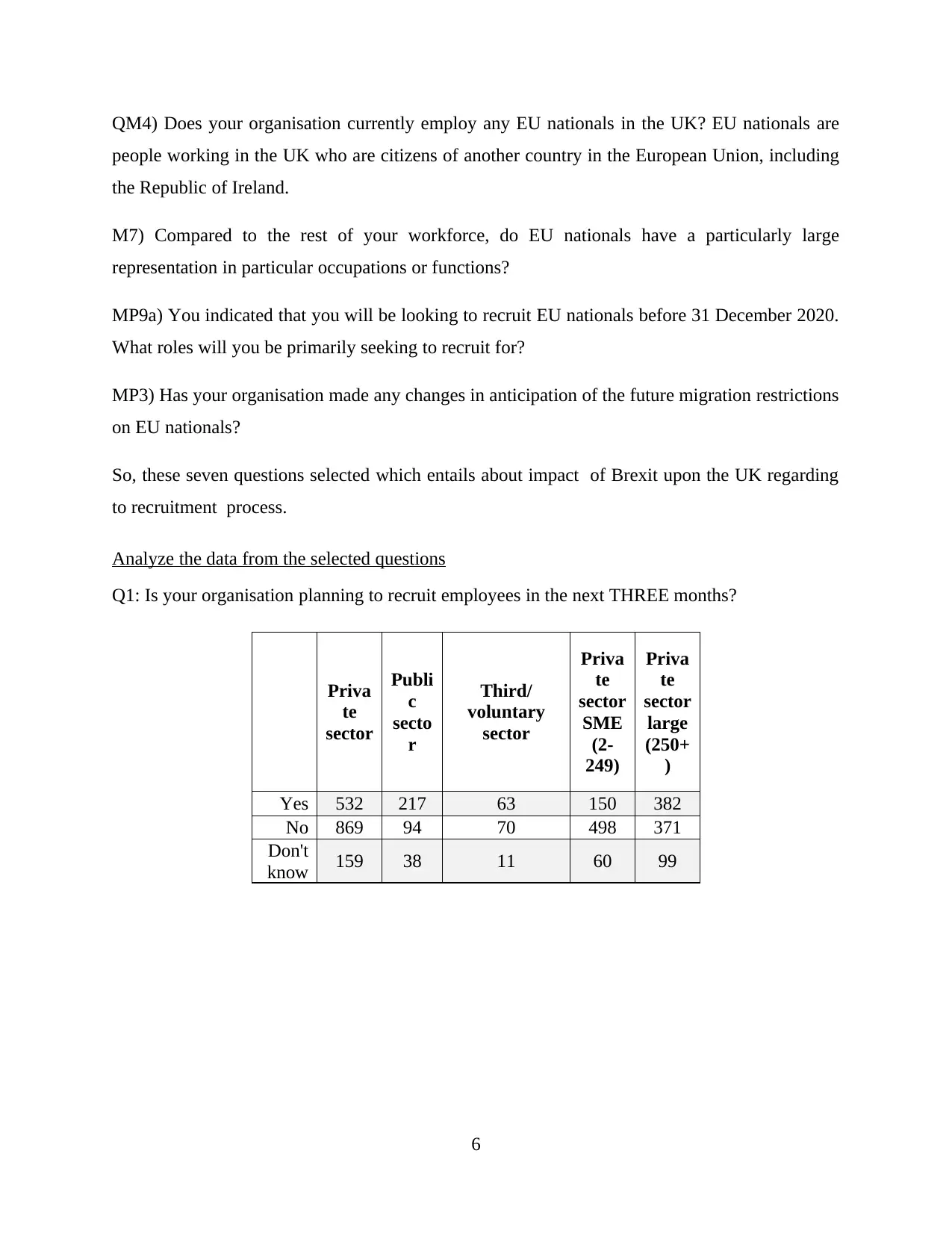
QM4) Does your organisation currently employ any EU nationals in the UK? EU nationals are
people working in the UK who are citizens of another country in the European Union, including
the Republic of Ireland.
M7) Compared to the rest of your workforce, do EU nationals have a particularly large
representation in particular occupations or functions?
MP9a) You indicated that you will be looking to recruit EU nationals before 31 December 2020.
What roles will you be primarily seeking to recruit for?
MP3) Has your organisation made any changes in anticipation of the future migration restrictions
on EU nationals?
So, these seven questions selected which entails about impact of Brexit upon the UK regarding
to recruitment process.
Analyze the data from the selected questions
Q1: Is your organisation planning to recruit employees in the next THREE months?
Priva
te
sector
Publi
c
secto
r
Third/
voluntary
sector
Priva
te
sector
SME
(2-
249)
Priva
te
sector
large
(250+
)
Yes 532 217 63 150 382
No 869 94 70 498 371
Don't
know 159 38 11 60 99
6
people working in the UK who are citizens of another country in the European Union, including
the Republic of Ireland.
M7) Compared to the rest of your workforce, do EU nationals have a particularly large
representation in particular occupations or functions?
MP9a) You indicated that you will be looking to recruit EU nationals before 31 December 2020.
What roles will you be primarily seeking to recruit for?
MP3) Has your organisation made any changes in anticipation of the future migration restrictions
on EU nationals?
So, these seven questions selected which entails about impact of Brexit upon the UK regarding
to recruitment process.
Analyze the data from the selected questions
Q1: Is your organisation planning to recruit employees in the next THREE months?
Priva
te
sector
Publi
c
secto
r
Third/
voluntary
sector
Priva
te
sector
SME
(2-
249)
Priva
te
sector
large
(250+
)
Yes 532 217 63 150 382
No 869 94 70 498 371
Don't
know 159 38 11 60 99
6
⊘ This is a preview!⊘
Do you want full access?
Subscribe today to unlock all pages.

Trusted by 1+ million students worldwide
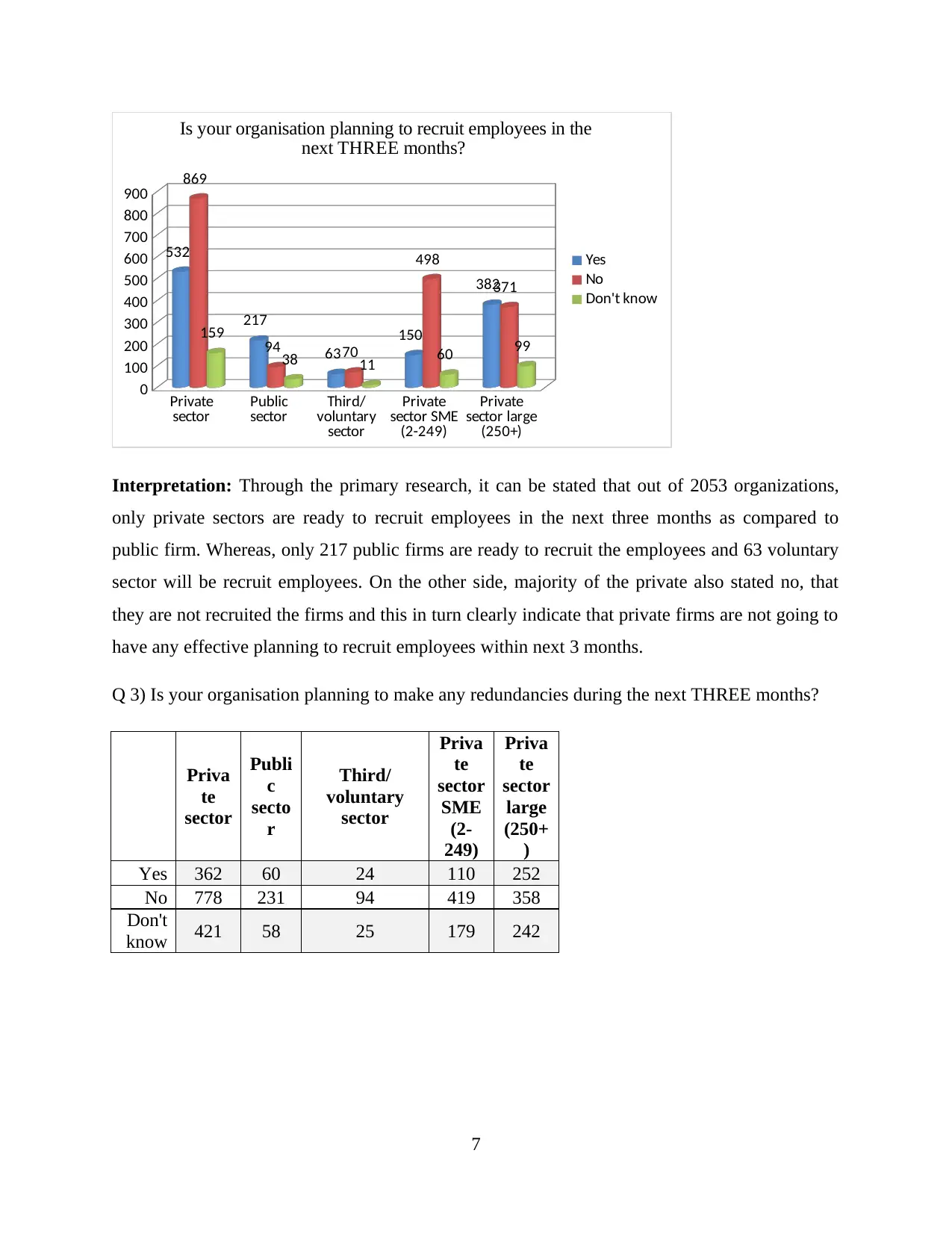
Private
sector Public
sector Third/
voluntary
sector
Private
sector SME
(2-249)
Private
sector large
(250+)
0
100
200
300
400
500
600
700
800
900
532
217
63
150
382
869
94 70
498
371
159
38 11 60 99
Is your organisation planning to recruit employees in the
next THREE months?
Yes
No
Don't know
Interpretation: Through the primary research, it can be stated that out of 2053 organizations,
only private sectors are ready to recruit employees in the next three months as compared to
public firm. Whereas, only 217 public firms are ready to recruit the employees and 63 voluntary
sector will be recruit employees. On the other side, majority of the private also stated no, that
they are not recruited the firms and this in turn clearly indicate that private firms are not going to
have any effective planning to recruit employees within next 3 months.
Q 3) Is your organisation planning to make any redundancies during the next THREE months?
Priva
te
sector
Publi
c
secto
r
Third/
voluntary
sector
Priva
te
sector
SME
(2-
249)
Priva
te
sector
large
(250+
)
Yes 362 60 24 110 252
No 778 231 94 419 358
Don't
know 421 58 25 179 242
7
sector Public
sector Third/
voluntary
sector
Private
sector SME
(2-249)
Private
sector large
(250+)
0
100
200
300
400
500
600
700
800
900
532
217
63
150
382
869
94 70
498
371
159
38 11 60 99
Is your organisation planning to recruit employees in the
next THREE months?
Yes
No
Don't know
Interpretation: Through the primary research, it can be stated that out of 2053 organizations,
only private sectors are ready to recruit employees in the next three months as compared to
public firm. Whereas, only 217 public firms are ready to recruit the employees and 63 voluntary
sector will be recruit employees. On the other side, majority of the private also stated no, that
they are not recruited the firms and this in turn clearly indicate that private firms are not going to
have any effective planning to recruit employees within next 3 months.
Q 3) Is your organisation planning to make any redundancies during the next THREE months?
Priva
te
sector
Publi
c
secto
r
Third/
voluntary
sector
Priva
te
sector
SME
(2-
249)
Priva
te
sector
large
(250+
)
Yes 362 60 24 110 252
No 778 231 94 419 358
Don't
know 421 58 25 179 242
7
Paraphrase This Document
Need a fresh take? Get an instant paraphrase of this document with our AI Paraphraser
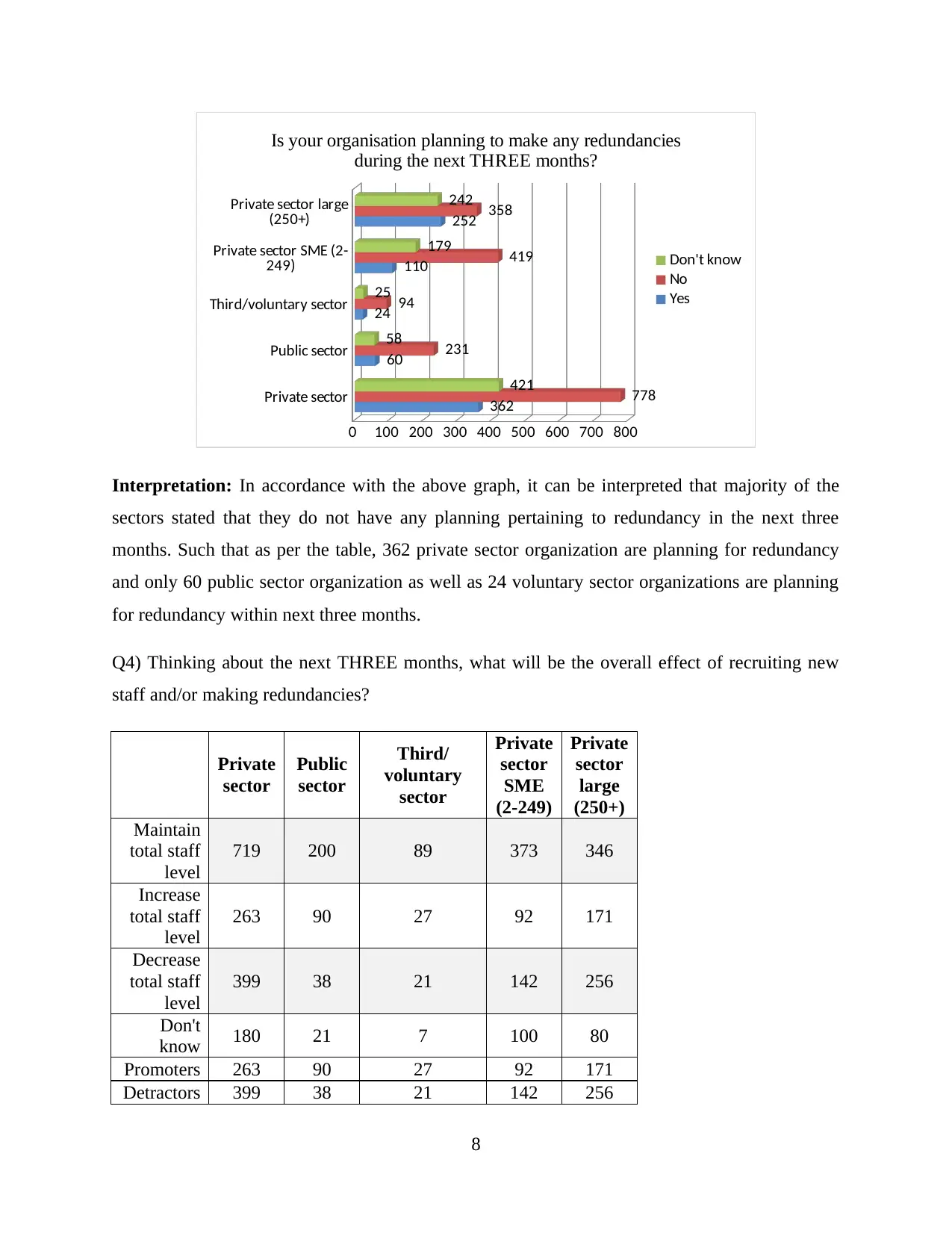
Private sector
Public sector
Third/voluntary sector
Private sector SME (2-
249)
Private sector large
(250+)
0 100 200 300 400 500 600 700 800
362
60
24
110
252
778
231
94
419
358
421
58
25
179
242
Is your organisation planning to make any redundancies
during the next THREE months?
Don't know
No
Yes
Interpretation: In accordance with the above graph, it can be interpreted that majority of the
sectors stated that they do not have any planning pertaining to redundancy in the next three
months. Such that as per the table, 362 private sector organization are planning for redundancy
and only 60 public sector organization as well as 24 voluntary sector organizations are planning
for redundancy within next three months.
Q4) Thinking about the next THREE months, what will be the overall effect of recruiting new
staff and/or making redundancies?
Private
sector
Public
sector
Third/
voluntary
sector
Private
sector
SME
(2-249)
Private
sector
large
(250+)
Maintain
total staff
level
719 200 89 373 346
Increase
total staff
level
263 90 27 92 171
Decrease
total staff
level
399 38 21 142 256
Don't
know 180 21 7 100 80
Promoters 263 90 27 92 171
Detractors 399 38 21 142 256
8
Public sector
Third/voluntary sector
Private sector SME (2-
249)
Private sector large
(250+)
0 100 200 300 400 500 600 700 800
362
60
24
110
252
778
231
94
419
358
421
58
25
179
242
Is your organisation planning to make any redundancies
during the next THREE months?
Don't know
No
Yes
Interpretation: In accordance with the above graph, it can be interpreted that majority of the
sectors stated that they do not have any planning pertaining to redundancy in the next three
months. Such that as per the table, 362 private sector organization are planning for redundancy
and only 60 public sector organization as well as 24 voluntary sector organizations are planning
for redundancy within next three months.
Q4) Thinking about the next THREE months, what will be the overall effect of recruiting new
staff and/or making redundancies?
Private
sector
Public
sector
Third/
voluntary
sector
Private
sector
SME
(2-249)
Private
sector
large
(250+)
Maintain
total staff
level
719 200 89 373 346
Increase
total staff
level
263 90 27 92 171
Decrease
total staff
level
399 38 21 142 256
Don't
know 180 21 7 100 80
Promoters 263 90 27 92 171
Detractors 399 38 21 142 256
8
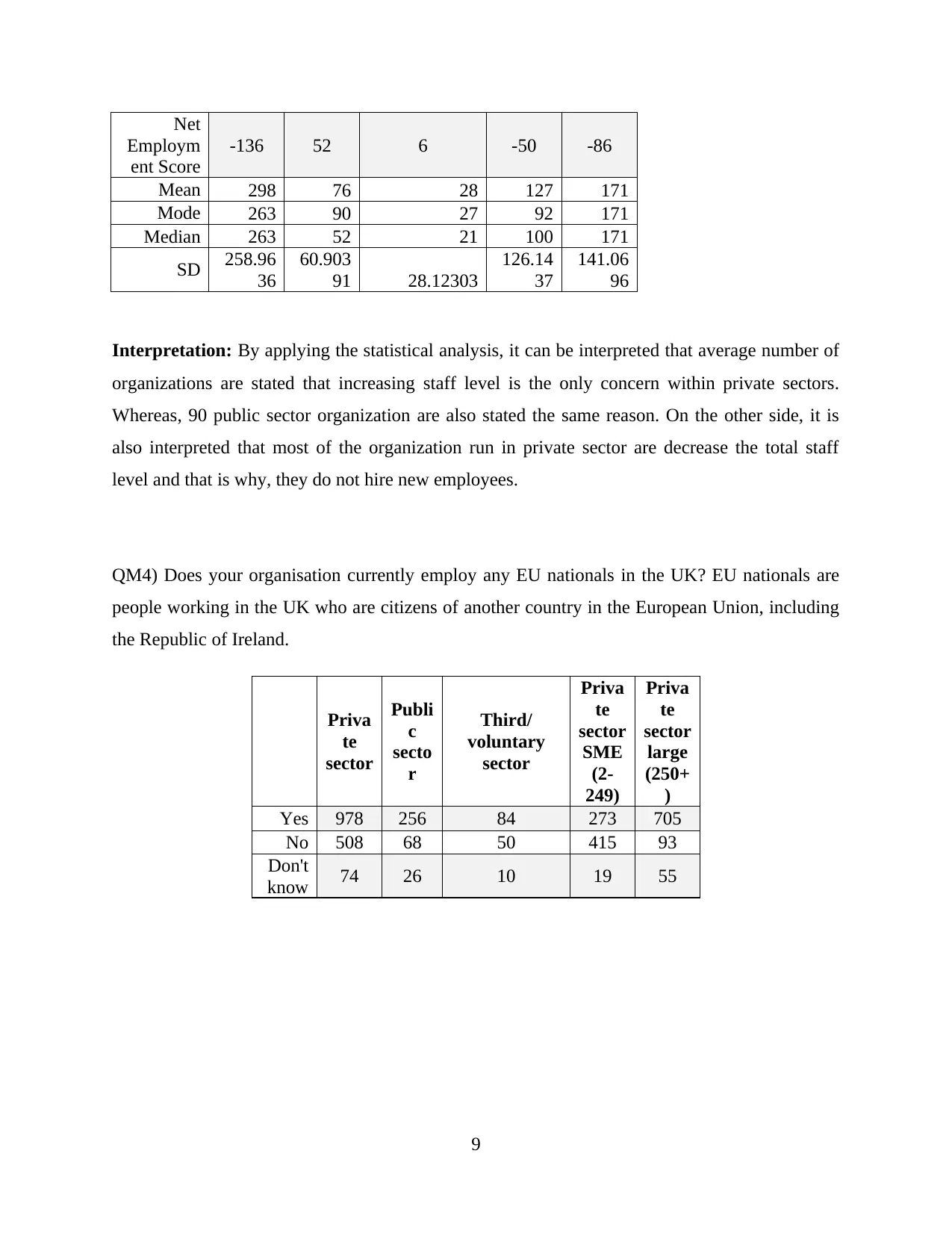
Net
Employm
ent Score
-136 52 6 -50 -86
Mean 298 76 28 127 171
Mode 263 90 27 92 171
Median 263 52 21 100 171
SD 258.96
36
60.903
91 28.12303
126.14
37
141.06
96
Interpretation: By applying the statistical analysis, it can be interpreted that average number of
organizations are stated that increasing staff level is the only concern within private sectors.
Whereas, 90 public sector organization are also stated the same reason. On the other side, it is
also interpreted that most of the organization run in private sector are decrease the total staff
level and that is why, they do not hire new employees.
QM4) Does your organisation currently employ any EU nationals in the UK? EU nationals are
people working in the UK who are citizens of another country in the European Union, including
the Republic of Ireland.
Priva
te
sector
Publi
c
secto
r
Third/
voluntary
sector
Priva
te
sector
SME
(2-
249)
Priva
te
sector
large
(250+
)
Yes 978 256 84 273 705
No 508 68 50 415 93
Don't
know 74 26 10 19 55
9
Employm
ent Score
-136 52 6 -50 -86
Mean 298 76 28 127 171
Mode 263 90 27 92 171
Median 263 52 21 100 171
SD 258.96
36
60.903
91 28.12303
126.14
37
141.06
96
Interpretation: By applying the statistical analysis, it can be interpreted that average number of
organizations are stated that increasing staff level is the only concern within private sectors.
Whereas, 90 public sector organization are also stated the same reason. On the other side, it is
also interpreted that most of the organization run in private sector are decrease the total staff
level and that is why, they do not hire new employees.
QM4) Does your organisation currently employ any EU nationals in the UK? EU nationals are
people working in the UK who are citizens of another country in the European Union, including
the Republic of Ireland.
Priva
te
sector
Publi
c
secto
r
Third/
voluntary
sector
Priva
te
sector
SME
(2-
249)
Priva
te
sector
large
(250+
)
Yes 978 256 84 273 705
No 508 68 50 415 93
Don't
know 74 26 10 19 55
9
⊘ This is a preview!⊘
Do you want full access?
Subscribe today to unlock all pages.

Trusted by 1+ million students worldwide
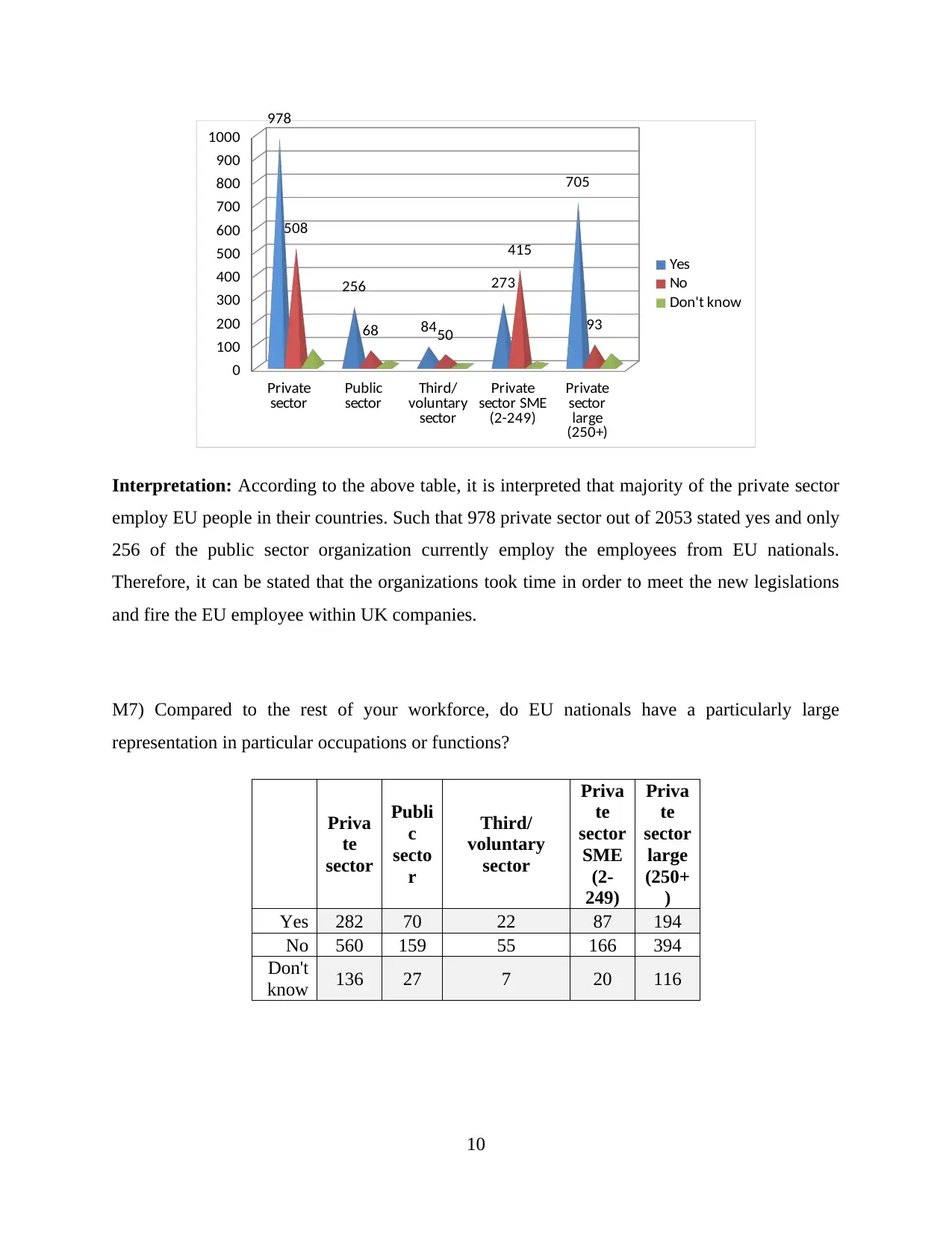
Private
sector Public
sector Third/
voluntary
sector
Private
sector SME
(2-249)
Private
sector
large
(250+)
0
100
200
300
400
500
600
700
800
900
1000
978
256
84
273
705
508
68 50
415
93
Yes
No
Don't know
Interpretation: According to the above table, it is interpreted that majority of the private sector
employ EU people in their countries. Such that 978 private sector out of 2053 stated yes and only
256 of the public sector organization currently employ the employees from EU nationals.
Therefore, it can be stated that the organizations took time in order to meet the new legislations
and fire the EU employee within UK companies.
M7) Compared to the rest of your workforce, do EU nationals have a particularly large
representation in particular occupations or functions?
Priva
te
sector
Publi
c
secto
r
Third/
voluntary
sector
Priva
te
sector
SME
(2-
249)
Priva
te
sector
large
(250+
)
Yes 282 70 22 87 194
No 560 159 55 166 394
Don't
know 136 27 7 20 116
10
sector Public
sector Third/
voluntary
sector
Private
sector SME
(2-249)
Private
sector
large
(250+)
0
100
200
300
400
500
600
700
800
900
1000
978
256
84
273
705
508
68 50
415
93
Yes
No
Don't know
Interpretation: According to the above table, it is interpreted that majority of the private sector
employ EU people in their countries. Such that 978 private sector out of 2053 stated yes and only
256 of the public sector organization currently employ the employees from EU nationals.
Therefore, it can be stated that the organizations took time in order to meet the new legislations
and fire the EU employee within UK companies.
M7) Compared to the rest of your workforce, do EU nationals have a particularly large
representation in particular occupations or functions?
Priva
te
sector
Publi
c
secto
r
Third/
voluntary
sector
Priva
te
sector
SME
(2-
249)
Priva
te
sector
large
(250+
)
Yes 282 70 22 87 194
No 560 159 55 166 394
Don't
know 136 27 7 20 116
10
Paraphrase This Document
Need a fresh take? Get an instant paraphrase of this document with our AI Paraphraser
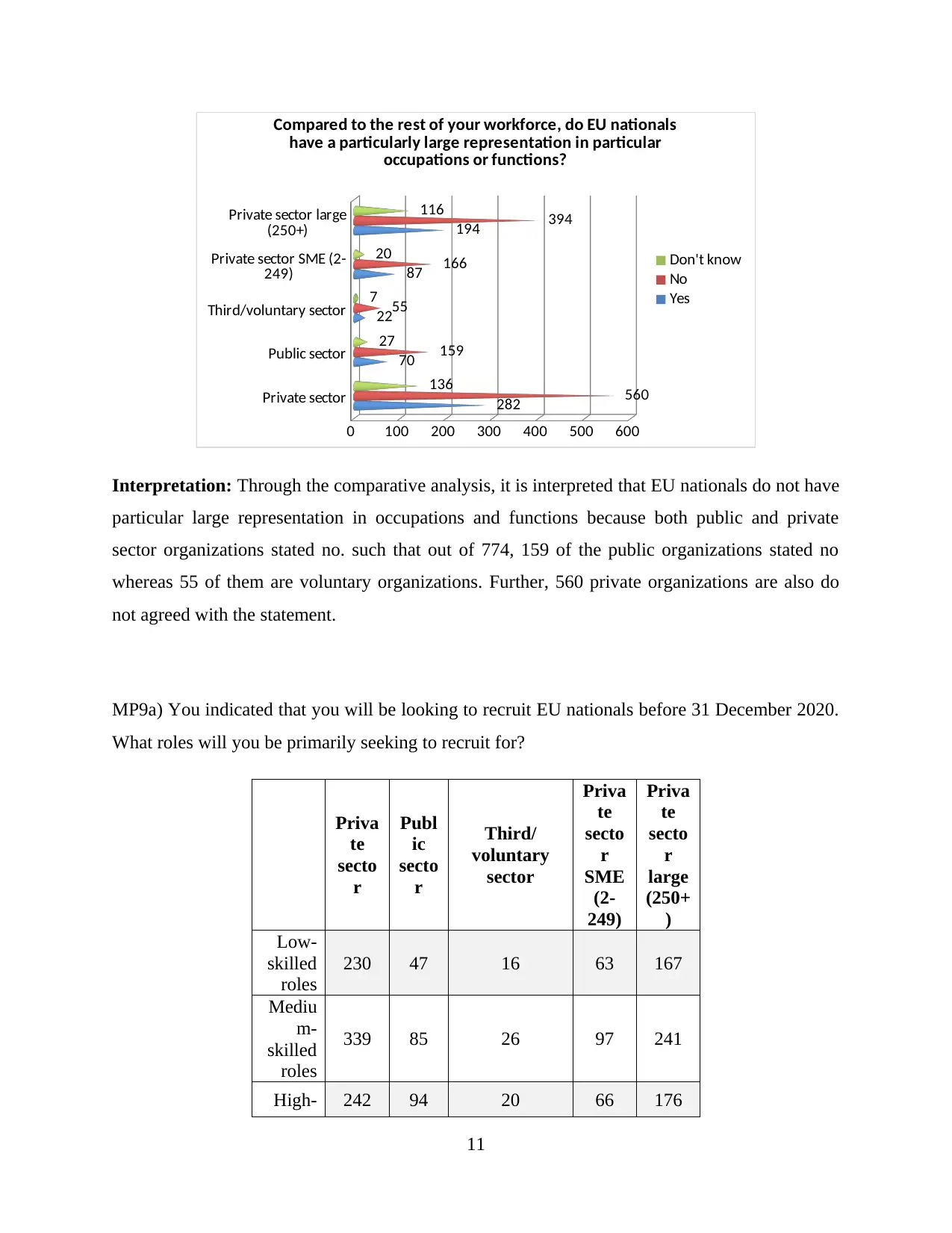
Private sector
Public sector
Third/voluntary sector
Private sector SME (2-
249)
Private sector large
(250+)
0 100 200 300 400 500 600
282
70
22
87
194
560
159
55
166
394
136
27
7
20
116
Compared to the rest of your workforce, do EU nationals
have a particularly large representation in particular
occupations or functions?
Don't know
No
Yes
Interpretation: Through the comparative analysis, it is interpreted that EU nationals do not have
particular large representation in occupations and functions because both public and private
sector organizations stated no. such that out of 774, 159 of the public organizations stated no
whereas 55 of them are voluntary organizations. Further, 560 private organizations are also do
not agreed with the statement.
MP9a) You indicated that you will be looking to recruit EU nationals before 31 December 2020.
What roles will you be primarily seeking to recruit for?
Priva
te
secto
r
Publ
ic
secto
r
Third/
voluntary
sector
Priva
te
secto
r
SME
(2-
249)
Priva
te
secto
r
large
(250+
)
Low-
skilled
roles
230 47 16 63 167
Mediu
m-
skilled
roles
339 85 26 97 241
High- 242 94 20 66 176
11
Public sector
Third/voluntary sector
Private sector SME (2-
249)
Private sector large
(250+)
0 100 200 300 400 500 600
282
70
22
87
194
560
159
55
166
394
136
27
7
20
116
Compared to the rest of your workforce, do EU nationals
have a particularly large representation in particular
occupations or functions?
Don't know
No
Yes
Interpretation: Through the comparative analysis, it is interpreted that EU nationals do not have
particular large representation in occupations and functions because both public and private
sector organizations stated no. such that out of 774, 159 of the public organizations stated no
whereas 55 of them are voluntary organizations. Further, 560 private organizations are also do
not agreed with the statement.
MP9a) You indicated that you will be looking to recruit EU nationals before 31 December 2020.
What roles will you be primarily seeking to recruit for?
Priva
te
secto
r
Publ
ic
secto
r
Third/
voluntary
sector
Priva
te
secto
r
SME
(2-
249)
Priva
te
secto
r
large
(250+
)
Low-
skilled
roles
230 47 16 63 167
Mediu
m-
skilled
roles
339 85 26 97 241
High- 242 94 20 66 176
11
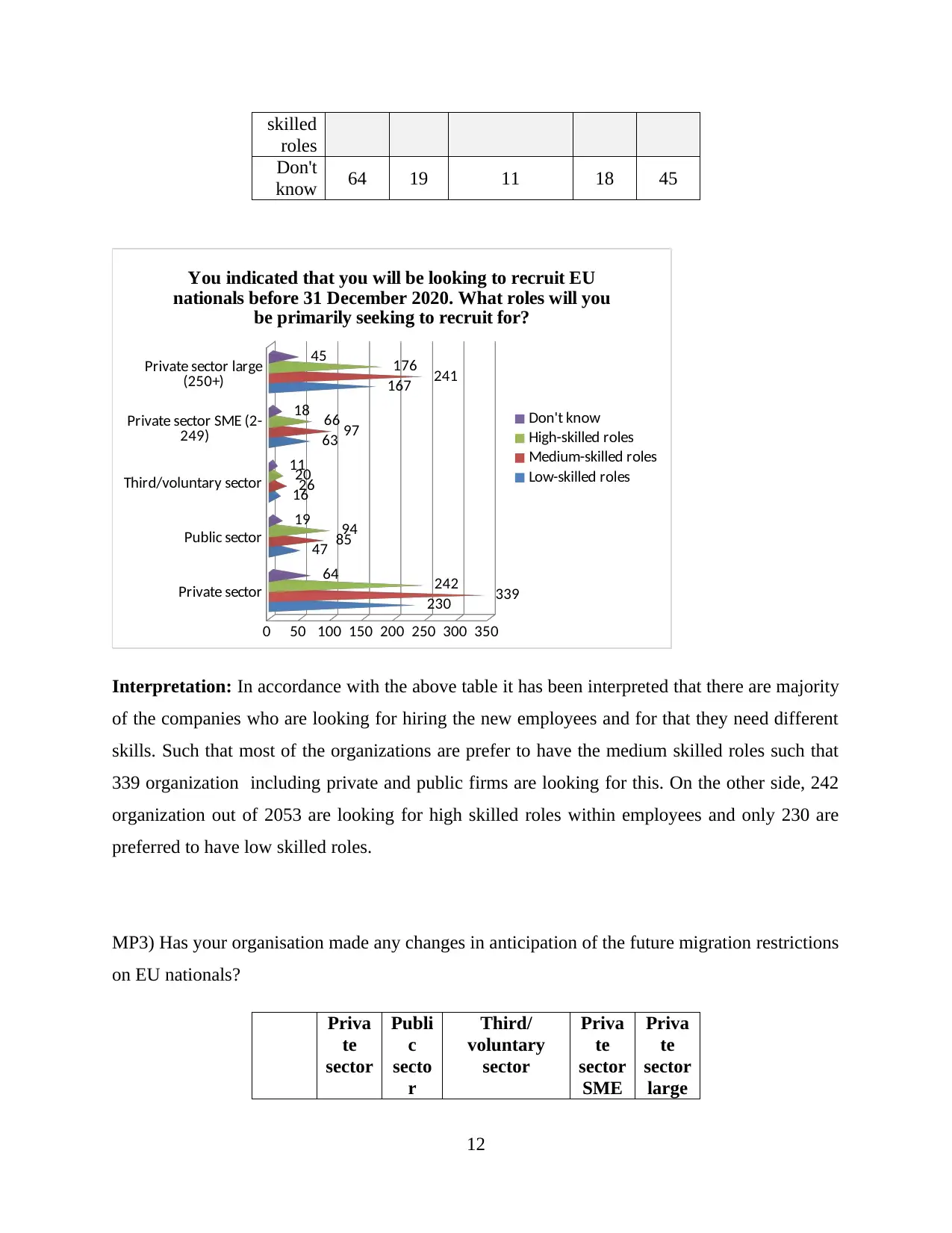
skilled
roles
Don't
know 64 19 11 18 45
Private sector
Public sector
Third/voluntary sector
Private sector SME (2-
249)
Private sector large
(250+)
0 50 100 150 200 250 300 350
230
47
16
63
167
339
85
26
97
241
242
94
20
66
176
64
19
11
18
45
You indicated that you will be looking to recruit EU
nationals before 31 December 2020. What roles will you
be primarily seeking to recruit for?
Don't know
High-skilled roles
Medium-skilled roles
Low-skilled roles
Interpretation: In accordance with the above table it has been interpreted that there are majority
of the companies who are looking for hiring the new employees and for that they need different
skills. Such that most of the organizations are prefer to have the medium skilled roles such that
339 organization including private and public firms are looking for this. On the other side, 242
organization out of 2053 are looking for high skilled roles within employees and only 230 are
preferred to have low skilled roles.
MP3) Has your organisation made any changes in anticipation of the future migration restrictions
on EU nationals?
Priva
te
sector
Publi
c
secto
r
Third/
voluntary
sector
Priva
te
sector
SME
Priva
te
sector
large
12
roles
Don't
know 64 19 11 18 45
Private sector
Public sector
Third/voluntary sector
Private sector SME (2-
249)
Private sector large
(250+)
0 50 100 150 200 250 300 350
230
47
16
63
167
339
85
26
97
241
242
94
20
66
176
64
19
11
18
45
You indicated that you will be looking to recruit EU
nationals before 31 December 2020. What roles will you
be primarily seeking to recruit for?
Don't know
High-skilled roles
Medium-skilled roles
Low-skilled roles
Interpretation: In accordance with the above table it has been interpreted that there are majority
of the companies who are looking for hiring the new employees and for that they need different
skills. Such that most of the organizations are prefer to have the medium skilled roles such that
339 organization including private and public firms are looking for this. On the other side, 242
organization out of 2053 are looking for high skilled roles within employees and only 230 are
preferred to have low skilled roles.
MP3) Has your organisation made any changes in anticipation of the future migration restrictions
on EU nationals?
Priva
te
sector
Publi
c
secto
r
Third/
voluntary
sector
Priva
te
sector
SME
Priva
te
sector
large
12
⊘ This is a preview!⊘
Do you want full access?
Subscribe today to unlock all pages.

Trusted by 1+ million students worldwide
1 out of 16
Related Documents
Your All-in-One AI-Powered Toolkit for Academic Success.
+13062052269
info@desklib.com
Available 24*7 on WhatsApp / Email
![[object Object]](/_next/static/media/star-bottom.7253800d.svg)
Unlock your academic potential
Copyright © 2020–2025 A2Z Services. All Rights Reserved. Developed and managed by ZUCOL.





